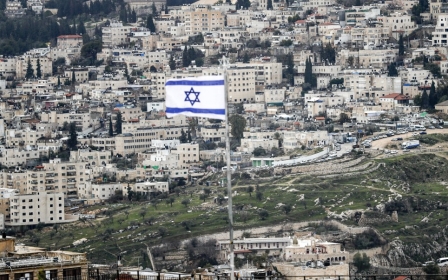Mizrahi Jews in Israel faced decades of injustice, and still vote extreme right
Amidst the ongoing political chaos following the inauguration of the new Israeli government last month, not only has the Israeli Jewish opposition taken to the streets to protest proposed judicial reforms, but calls issued by high-ranking Israeli generals for civil disobedience have also become common.
The current political melee is not restricted to what passes in Israel as a left-right division - or more accurately, a situation of extreme right versus very extreme right - but has also taken an ethnic turn.
The opposition to the government was recently described by a Likud lawmaker as representing rich and privileged Ashkenazi Jews intent on continuing to subjugate Moroccan, if not all Mizrahi, Jews (and even Palestinian Druze).
'I saw a lot of things glistening at the demonstration, and later I realised it was the Rolex watches worn by the protesters'
- David Amsalem, Likud MK
Born in Jerusalem to Moroccan Jewish parents, Likud Knesset member David (Dudi) Amsalem, did not mince words: “You’re a gang of thugs, inciting to rebellion.”
Amsalem, whom Benjamin Netanyahu recently appointed as Israel’s junior minister at the justice ministry, added: “Former IDF Chief of Staff Dan Halutz said that he would give an order not to report for reserve service. And these are the people who are supposedly protecting us and working [for the country].
Stay informed with MEE's newsletters
Sign up to get the latest alerts, insights and analysis, starting with Turkey Unpacked
"Well, I have something to tell you. I also work, me, and another two and a half million people, we all work for the country, even though it's quite true that most of us work for you, cleaning your houses and gardens. I saw a lot of things glistening at the demonstration, and later I realised it was the Rolex watches worn by the protesters. Just go and see how many Mercedes they have."
Referring to Moroccan Jews, Amsalem concluded: "You're prepared to give us degrees and even cars, but not to allow us to rule. You never granted us that: not in the security forces, not in the judicial system, not in academia, not in culture, and certainly not in the Supreme Court and the state prosecution service. And in the Prisons Service, do you know who the wardens are? Moroccans and Druze."
The opposition was not cowed by his remarks and accused him of hypocrisy, as he himself sported a Cartier watch and is highly paid (Amsalem retorted that the watch, which has sentimental value, was given to him by his brother before he passed away).
'Oriental communities'
The ethnic division between Israeli Jews, especially between the European Ashkenazi Jews and the Asian and African Jews, most of whom hail from the Arab world, is as old as the Zionist project, although it did not become explosive until after the Jewish settler colony was founded in 1948.
Israeli officials would especially denigrate Moroccan Jews, the poorest of what Israel called the "Oriental communities", who later became known as the "Mizrahim".
Israel’s first prime minister, David Ben Gurion, had the following to say: "Those [Jews] from Morocco had no education. Their customs are those of Arabs." He asserted that "The Moroccan Jew took a lot from the Moroccan Arabs. The culture of Morocco I would not like to have here."
Ben Gurion concluded: "We do not want Israelis to become Arabs. We are in duty bound to fight against the spirit of the Levant, which corrupts individuals and societies, and preserve the authentic Jewish values as they crystallised in the [European] Diaspora."
One of the crueller chapters of this period involved the kidnapping of hundreds of children of Yemeni Jews from the transit camps in Israel. Some of the children were given to childless Ashkenazi couples for adoption in and outside of Israel. Yemeni parents whose children were sick were taken from them to hospitals where the parents were prevented from going.
The parents were later told that their children had died. Twenty years later, in 1968, the Ministry of Defence sent military draft notices to the addresses of the parents of these children.
An investigation was launched by the Knesset in March 1968, but no satisfactory answers were found. Yet, the affair was sophisticated enough to produce death certificates for some of the kidnapped children and to obstruct for decades all attempts by their parents to investigate the crime. In 1986, a massive rally was held by "The Public Committee for the Discovery of the Missing Yemeni Children".
Upon their arrival in Israel, the "Oriental" Jews were crammed in transit camps under poor conditions, while Ashkenazi immigrants were given the homes of the ethnically cleansed Palestinians.
Demonstrations took place in the camps protesting discrimination, food shortages, and lack of medical care. The transit camps were erected next to Ashkenazi settlements and large cities to provide the latter with cheap labour. This was on the orders of the government, which, after the initial provision of meagre rations and social services, informed the camp residents that they needed to provide for themselves through work in the Ashkenazi settlements.
They continue to benefit from the privilege of being Jewish, a privilege denied to the Palestinians, even as they face discrimination for being non-European
Due to high levels of unemployment, many Oriental Jews, regardless of their level of education or skills, had to take up menial unskilled jobs - the only ones on offer.
Demonstrations took place throughout the country in 1949. In Ashkelon (formerly Majdal ‘Asqalan), thousands of Oriental Jews marched against discrimination. Similarly, 300 residents from Ramleh staged a "noisy" demonstration in Allenby Street demanding "bread and work" and tried to storm the old Knesset building until they were held back by police.
Two weeks later, demonstrators stormed the Jewish Agency building in Haifa and went on a rampage inside the Department of Absorption. They demanded "work and housing" from the organisation, which was set up by the World Zionist Organisation in 1929 as its operational branch for the Jewish colonisation of Palestine.
This time the police only managed to overpower them by bringing in reinforcements. Some demonstrators were injured, and others were arrested. In July of the same year, demonstrators from Jaffa attacked the former parliament building in Tel Aviv.
Asian and African Jews were settled in what Israel named "development towns" and in poor-quality agricultural cooperatives called "moshavim". Others lived in slums in the big cities of Tel Aviv, Jerusalem, Haifa and Beersheba. It is in these urban slums that resistance to racism and economic deprivation would arise.
Iraqi Jewish writer Gideon Giladi explains that the "only basic economic difference between the development towns and the slum areas is geographic. The development towns lie in the country and supply the Ashkenazi settlements with cheap labour whereas the slum areas form a belt around the large towns and supply Ashkenazi capital with cheap labour. They also provide servants for Ashkenazi women."
Amsalem’s reference to Moroccans working for rich Ashkenazi families was not arbitrary; it is based on the details of this history.
Mizrahi uprisings
The first Moroccan Jewish uprising in Israel took place in 1959 in the poor Wadi al-Salib neighbourhood of Haifa, whose Palestinian population had been replaced by Moroccan Jews.
Poor Moroccan Jews were also in the forefront of the second and more momentous movement of the Israeli Black Panthers, which dominated the Israeli scene from 1970 to 1973. In May 1971, at one of their largest demonstrations, 260 Black Panthers supporters were arrested by the police who broke up the demonstration.
The chief of police at the time, Shlomo Hillel, of Iraqi origin, was labelled by the demonstrators "the black collaborator". More demonstrations followed in January and May 1972 in which more police clashes led to shootings.
This led to the biggest mass protest vote in Israeli history on the part of a majority of Mizrahim who helped to bring a Likud-led coalition to power in 1977, ending, for the first time since Israel’s creation, the monopoly on political leadership held by the Labor Party.
The irony then as now was that Likud, just like Labor, was (and remains) also Ashkenazi-led and dominated, but the difference was that it was not in power between 1948 and 1977 when the Oriental Jews were subjected to systematic discrimination.
Confrontations with police continued in the 1980s, with a major demonstration following the fatal police shooting of Shimon Yehoshua, a Yemeni Jew, on 22 December 1982.
The murder took place after the police arrived at Yehoshua’s house in Kfar Shalem in Tel Aviv, intent on destroying an extra room he had added to his house without a government licence. Yehoshua was shot while resisting police attempts at demolishing the room (a common Israeli practice against Palestinians, and in this case, a Mizrahi Jew, but not Ashkenazim).
Wide demonstrations broke out a few days after the murder prompting the Knesset to delay Yehoshua’s burial until nightfall to prevent disturbances. Following the demolition of more than 100 buildings in Kfar Shalem in 1984 more bloody clashes occurred.
Demonstrators set fire to a warehouse, blocked the main streets shouting "Ashke-Nazis" at the police, which, by then, was a common epithet used by Mizrahi protesters.
The matter of the kidnapped Yemeni children also continued to mobilise people against the racism of the Ashkenazi state. In 1994, a force of 800 police officers laid a five-week siege to the home of the Yemeni-born rabbi Uzi Meshulem and a few dozen of his Mizrahi followers in Yehud (near Petah Tikva) who were demanding information about the kidnapped children.
Remaining loyal
Despite ongoing discrimination, the majority of Mizrahi Jews have, of course, remained within the Zionist Israeli camp and, like their Ashkenazi compatriots, remain as colonisers of the land of the Palestinians. Amsalem himself is a settler in the West Bank colony of Ma’alei Adumim.
They continue to benefit from the privilege of being Jewish, a privilege denied to the Palestinians, even as they face discrimination by the Ashkenazim for being non-European. Yet gaps in income, wealth, education and health between Ashkenazim and Mizrahim have only increased in recent decades.
Amsalem, a beneficiary of the mobilisation of Mizrahi votes for Likud since 1977, is certainly exploiting this history of discrimination to mobilise Mizrahi Jews to the cause of the Ashkenazi-led government in Israel.
That his use of this history is a cynical move to drum up support for Israel’s extreme right-wing does not mitigate the fact that the discriminatory record he cites is one that continues to animate Mizrahi rage against ongoing Ashkenazi domination.
The views expressed in this article belong to the author and do not necessarily reflect the editorial policy of Middle East Eye.
Middle East Eye delivers independent and unrivalled coverage and analysis of the Middle East, North Africa and beyond. To learn more about republishing this content and the associated fees, please fill out this form. More about MEE can be found here.






